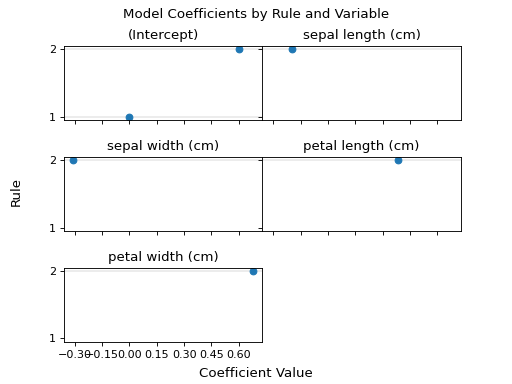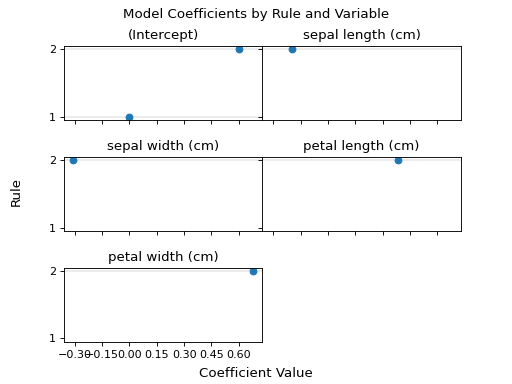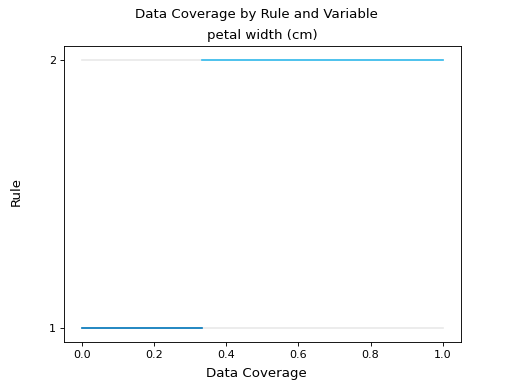Visualizations¶
Cubist Coefficient Display¶
- class cubist.cubist_coefficient_display.CubistCoefficientDisplay(*, coeffs: DataFrame)[source]¶
Visualization of the regression coefficients used in the Cubist model.
This tool plots the linear coefficients and intercepts created for a Cubist model and stored in the coeffs_ attribute. One subplot is created for each variable or intercept with the rule number or committee/rule pair on the y-axis. The coefficient values for the given variable and rule pair or variable and committee/rule pair are plotted along the x-axis.
See the details in the docstrings of
from_estimator()to create a visualizer. All parameters are stored as attributes.Added in version 1.0.0.
- Parameters:
- coeffspd.DataFrame
DataFrame containing the linear model coefficients by variable, committee, and rule.
- Attributes:
- ax_matplotlib Axes
Axes with the different matplotlib axis.
- figure_matplotlib Figure
Figure containing the scatter and lines.
See also
CubistCoefficientDisplay.from_estimatorPlot the coefficients used in the Cubist model.
Examples
>>> import matplotlib.pyplot as plt >>> from sklearn.datasets import load_iris >>> from cubist import Cubist, CubistCoefficientDisplay >>> X, y = load_iris(return_X_y=True, as_frame=True) >>> model = Cubist(n_rules=2).fit(X, y) >>> display = CubistCoefficientDisplay.from_estimator(estimator=model) >>> plt.show()

- plot(ax=None, y_label_map: dict = None, *, y_axis_label: str = None, gridspec_kwargs: dict = None, scatter_kwargs: dict = None)[source]¶
Plot visualization.
Extra keyword arguments will be passed to matplotlib’s
subplotsandscatter.- Parameters:
- axmatplotlib axes, default=None
Axes object to plot on. If None, a new figure and axes is created.
- y_label_mapdict, default=None
Dictionary mapping ordered value to the y-axis tick label so that matplotlib correctly orders committee/rule pairs in addition to rule numbers along the y-axis.
- y_axis_labelstr, default=None
Y-axis label for plot.
- **gridspec_kwargsdict
Additional keywords arguments passed to matplotlib matplotlib.pyplot.subplots function.
- **scatter_kwargsdict
Additional keywords arguments passed to matplotlib matplotlib.pyplot.scatter function.
- Returns:
- display
CubistCoefficientDisplay Object that stores computed values.
- display
- classmethod from_estimator(estimator: Cubist, *, committee: int = None, rule: int = None, feature_names: list = None, ax=None, scatter_kwargs=None, gridspec_kwargs=None)[source]¶
Plot the coefficients used in the Cubist model.
Added in version 1.0.0.
- Parameters:
- estimatorCubist instance
Fitted Cubist regressor.
- committeeint
Max committee number to be included in plot.
- ruleint
Max rule number to be included in plot.
- feature_nameslist of str
Feature names to filter to in the plot. Leaving unset plots all features.
- axmatplotlib axes, default=None
Axes object to plot on. If None, a new figure and axes is created.
- scatter_kwargsdict, default=None
Dictionary with keywords passed to the matplotlib.pyplot.scatter call.
- gridspec_kwargsdict, default=None
Dictionary with keyword passed to the matplotlib.pyplot.subplots call to configure the subplot.
- Returns:
- display
CubistCoefficientDisplay Object that stores the computed values.
- display
See also
CubistCoefficientDisplayCubist coefficient visualization.
Examples
>>> import matplotlib.pyplot as plt >>> from sklearn.datasets import load_iris >>> from cubist import Cubist, CubistCoefficientDisplay >>> X, y = load_iris(return_X_y=True, as_frame=True) >>> model = Cubist(n_rules=2).fit(X, y) >>> display = CubistCoefficientDisplay.from_estimator(estimator=model) >>> plt.show()

Cubist Coverage Display¶
- class cubist.cubist_coverage_display.CubistCoverageDisplay(*, splits: DataFrame)[source]¶
Visualization of rule split coverage for input variables for a trained Cubist model.
This tool plots the percents and ranges (coverage) per rule of input variables from a given dataset. One subplot is created for each variable used to make splits with the rule number or committee/rule pair on the y-axis. The coverage percentages for the given variable and rule pair or variable and committee/rule pair are plotted along the x-axis.
See the details in the docstrings of
from_estimator()to create a visualizer. All parameters are stored as attributes.Added in version 1.0.0.
- Parameters:
- splitspd.DataFrame
DataFrame containing the model split values by variable, committee, and rule.
- Attributes:
- ax_matplotlib Axes
Axes with the different matplotlib axis.
- figure_matplotlib Figure
Figure containing the scatter and lines.
See also
CubistCoverageDisplay.from_estimatorCubist input variable coverage visualization.
Examples
>>> import matplotlib.pyplot as plt >>> from sklearn.datasets import load_iris >>> from cubist import Cubist, CubistCoverageDisplay >>> X, y = load_iris(return_X_y=True, as_frame=True) >>> model = Cubist(n_rules=2).fit(X, y) >>> display = CubistCoverageDisplay.from_estimator(estimator=model, X=X) >>> plt.show()

- plot(ax=None, y_label_map: dict = None, *, y_axis_label: str = None, gridspec_kwargs: dict = None, line_kwargs: dict = None)[source]¶
Plot visualization.
Extra keyword arguments will be passed to matplotlib’s
subplotsandplot.- Parameters:
- axmatplotlib axes, default=None
Axes object to plot on. If None, a new figure and axes is created.
- y_label_mapdict, default=None
Dictionary mapping ordered value to the y-axis tick label so that matplotlib correctly orders committee/rule pairs in addition to rule numbers along the y-axis.
- y_axis_labelstr, default=None
Y-axis label for plot.
- **gridspec_kwargsdict
Additional keywords arguments passed to matplotlib matplotlib.pyplot.subplots function.
- **line_kwargsdict
Additional keywords arguments passed to matplotlib matplotlib.pyplot.plot function.
- Returns:
- display
CubistCoverageDisplay Object that stores computed values.
- display
- classmethod from_estimator(estimator: Cubist, X, *, committee: int = None, rule: int = None, feature_names: list = None, ax=None, line_kwargs=None, gridspec_kwargs=None)[source]¶
Plot the input variable coverage for rules used in the Cubist model.
Added in version 1.0.0.
- Parameters:
- estimatorCubist instance
Fitted Cubist regressor.
- Xarray-like of shape (n_samples, n_features)
Training data, where n_samples is the number of samples and n_features is the number of features.
- committeeint
Max committee number to be included in plot.
- ruleint
Max rule number to be included in plot.
- feature_nameslist of str
Feature names to filter to in the plot. Leaving unset plots all features.
- axmatplotlib axes, default=None
Axes object to plot on. If None, a new figure and axes is created.
- line_kwargsdict, default=None
Dictionary with keywords passed to the matplotlib.pyplot.plot call.
- gridspec_kwargsdict, default=None
Dictionary with keyword passed to the matplotlib.pyplot.subplots call to configure the subplot.
- Returns:
- display
CubistCoverageDisplay Object that stores the computed values.
- display
See also
CubistCoverageDisplayCubist input variable coverage visualization.
Examples
>>> import matplotlib.pyplot as plt >>> from sklearn.datasets import load_iris >>> from cubist import Cubist, CubistCoverageDisplay >>> X, y = load_iris(return_X_y=True, as_frame=True) >>> model = Cubist(n_rules=2).fit(X, y) >>> display = CubistCoverageDisplay.from_estimator(estimator=model, X=X) >>> plt.show()
